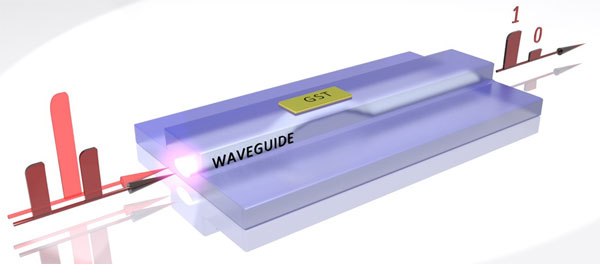
Optical Memory Chip Uses Phase-Change Material
The first demonstration of a stable nanoscale optical memory chip could allow storage and retrieval of data without the latency inherent in electronic systems.
The prototype, developed by researchers in Germany and England, incorporates phase-change materials onto which data can be encoded and erased using ultrashort light pulses.
"Optical bits can be written in our system at frequencies of up to a gigahertz or more," said Oxford University professor Harish Bhaskaran, "and our approach can define a new speed limit for future processors, by delivering extremely fast on-chip optical data storage."
Electronic exchange of data between processors and memory limits the speed of modern computers. This phenomenon is called the von Neumann bottleneck.
Although optical fiber has long been used to speed data transfer, the optical signals still have to be converted into electric signals at their destination. Permanent all-optical on-chip memories might considerably increase future performance of computers and reduce their energy consumption.
Photonic memories demonstrated to date have been volatile, according to the team behind the present work. Their approach was to use the phase-change material Ge2Sb2Te5 (GST).

Ultrashort light pulses make the GST material change from crystalline to amorphous and back. Weak light pulses read out the data. Courtesy of C. Rios/Oxford University.
The distinguishing feature of phase-change materials is that they radically change their optical properties depending their phase state, or the arrangement of the atoms within them.
This changeability between crystalline (regular) and amorphous (irregular) states allows storage of many bits in a single integrated nanoscale optical phase-change cell. The material can be changed between these two states using ultrashort light pulses with energies as low as 13.4 pJ; weak pulses can also be used to read the data.
Instead of the usual information values of 0 and 1, several states can be stored in an element, and autonomous calculations can be made, the researchers said.
And unlike most current on-chip memories, GST maintains its written state even when power is removed, meaning data can be stored in this way for decades.
"Our technology might also eventually be used to reproduce in computers the neural-type processing that is carried out by the human brain," said University of Exeter engineering professor David Wright.
The research was published in Nature Photonics (doi: 10.1038/nphoton.2015.182).
Published: September 2015